
Fast Growing Trees to Plant in the Fall

Are you looking to add some beautiful, fast growing trees for your yard? Did you know fall is the perfect time to plant a tree?
Believe it or not, but fall, not spring is the best time of the year to plant your trees. Today, we will explore why that is.
We are also exploring what trees you can still plant this fall that grow quickly, giving your yard the more mature look you want.
Fall is the Best Time to Plant
Tom Tyler of Bartlett Tree Experts told Organic Gardening why fall is the best season to plant trees. He explained that:
- The soil is more accessible due to the fall rains and provides the perfect amount of moisture.
- Root growth increases in the fall season, adding to the tree’s stability and making sure it is ready for a spring growth spurt.
Cathy Isom of AGnet West has this to say about fall tree planting: While summer may seem like the ideal growing time for most plants, it’s counterintuitively the worst time for tree growth.
Trees often have to fight the heat of summer for survival.
We think of winter as the harshest season, but it’s not the harshest season for a tree. Trees hibernate in the winter.
Fall planting is ideal because the soil is cool and moist, and as long as the ground isn’t frozen, you can still plant a tree.
The ideal time to plant is a few weeks before the ground becomes routinely frozen, as this can inhibit root growth through the winter.
Follow Basic Tree Planting Rules
As with any new tree, follow the basic rules for best results
- Make your planting hole roughly twice as wide as the diameter of the pot or root ball.
- Only dig deep enough to put the tree at ground level. Be sure not to cover the tree’s collar.
- Put a thick layer of wood mulch around the tree out to the drip line, but keep it away from the trunk.
To sum up, we’re not saying you can’t plant new trees in spring. However, to give your tree its best chance of survival, it is best to plant in the fall.
7 Fast Growing Trees to Plant in the Fall
Everyone loves a lawn with a few mature trees in it. When you move somewhere new, though, it can be challenging to wait for those trees to grow.
Here is a list of fast-growing trees that you might like to consider, along with pros and cons for each type of fast-growing tree.
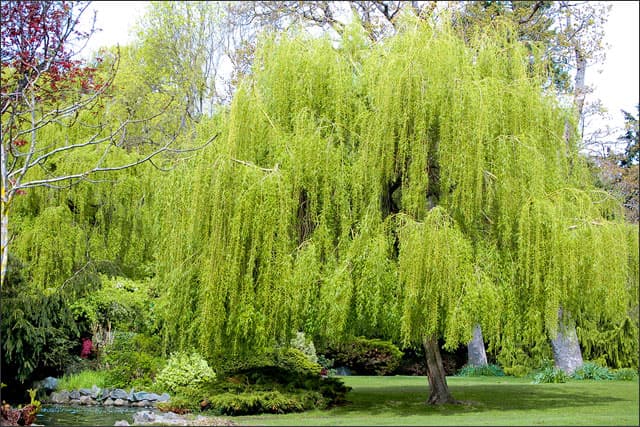
Weeping willow tree
Weeping Willow
Weeping willow trees are fast growing trees and depending on the cultivar, they can grow from 3 to 8 feet per year. They prefer sunny locations with plenty of water.
One con of weeping willow trees is that they attract insects. In addition, they are messy as the tendrils tend to drop making extra yard work.
Chinese Tallow Tree
As with any of the fast growing trees, the Chinese Tallow has some significant pros and major cons.
It can be an excellent replacement for poplar trees in warmer regions of the world because it is less prone to pests and can withstand drought and crowding better than many other plants.
It grows up to 18 inches every year, eventually reaching 40 feet if left to itself. However, some gardeners prefer to keep it as a small ornamental tree. As such, it will be high-maintenance.
The flowers and fruit will fall and make a mess. The leaves are big and broad and change to a beautiful color in the fall, but the fruit and leaves are toxic to humans and cattle.
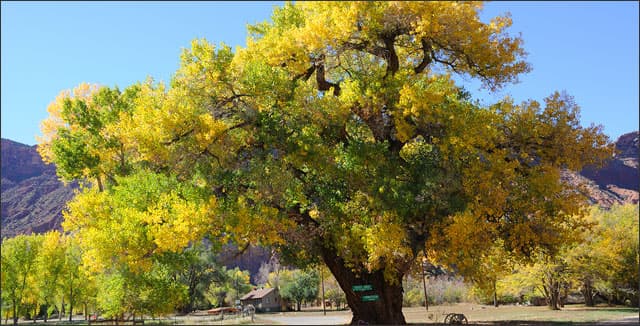
Cottenwood tree
Cottonwood Tree
Cottonwood trees are especially useful for providing shade, and they grow well along rivers and in marshy areas.
They are the fastest-growing tree in North America, growing up to 6 feet in a year and topping out at around 100 feet! That’s massive!
They grow well in every kind of soil but heavy clay. They make excellent windbreaks because they grow so quickly.
However, for the same reason, they have weak wood that hollows out or gets destroyed by storms easily as well. This is not the kind of tree to plant near your house. Cottonwoods are often used for pallets and paper.
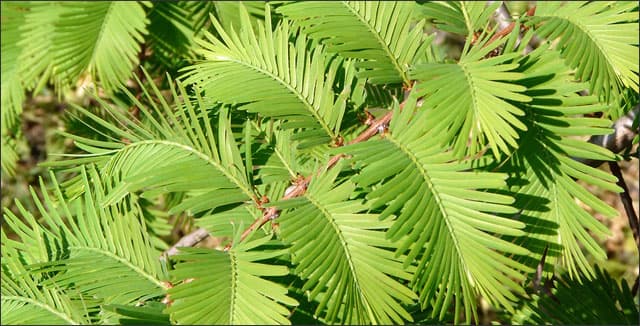
Dawn redwood branch
Dawn Redwood
Dawn redwood trees are of the elusive deciduous conifer variety. During the growing season they resemble evergreens.
However, their needles grow golden brown and drop in the fall, leaving the beautiful “bones” and bark of the tree through the winter.
Dawn redwoods grow about two feet per year in moist or wet soil and sun or shade and top out at around 80 feet.
These beauties may not do well being planted in late fall, if there’s an early fall freeze.
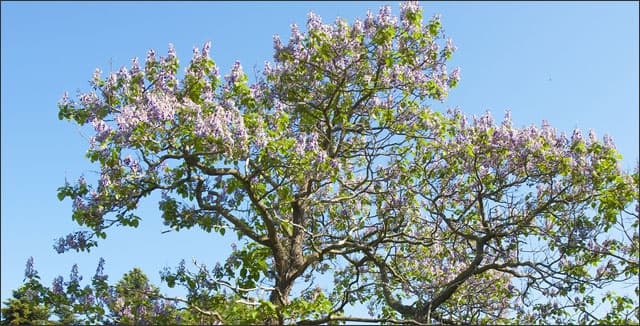
Empress tree
Empress Tree
Also called the Princess Tree or Royal Empress Tree, this unusual-looking tree has beautiful purple blooms and grows at least 2 feet per year. Not only does it grow up, it also grows out, reaching 50 feet tall and wide.
There are local restrictions on this tree, however, as its ability to survive robs native plants of resources.
One tree produces millions of seeds that spread far and wide and choke out more diverse life along banks of streams each year.
European Black Alder
Brought to the east coast of the United States by early European settlers, the European Black Alder has some fantastic properties which allow it to thrive.
Like other plants from the bean family, it can fix nitrogen from the air, allowing it to grow almost anywhere and displace native plants.
The trees grow aggressively when they are young, ruining sidewalks and sewer lines, and slow as they approach 60 feet tall and 40 feet wide.
Their seeds can travel far on waterways and colonize quickly, making this tree another species that may be restricted in your area.
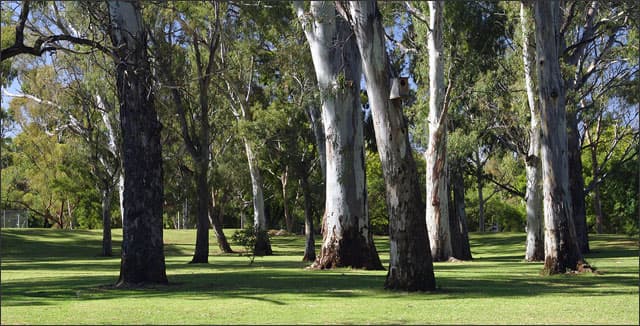
Gum trees
Gum Trees
Sweet gum trees have long been used for their medicinal properties by Native Americans. Their sap, fruit, and bark can be used to treat rheumatic diseases, dysentery, diarrhea, bedsores, herpes, and skin problems.
Gum trees thrive in the dry climates of the southwest and are prized for their large, shady canopies that turn vibrant red, orange, yellow, and purple in the fall. They grow up to 150 feet tall.
Preparing Your Newly Planted Trees for Winter
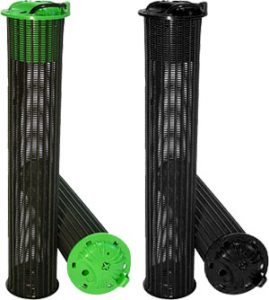
Rootwell Pro-318 Deep Root Watering System
Your newly planted trees will need plenty of water before the first frost. We recommend installing Rootwell Pro-318s when planting new trees. Rootwell Pro-318s are aeration tubes that are scientifically proven to help trees take root and encourage those roots to grow deep into the soil.

